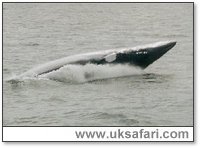
|

|
|
 Sent
to you Sent
to you
by e-mail
|
|
Simply
enter your details and hit the send button
more
info |
|


Click Here

Links
Advertise
Terms of Use
Contributors
About Us
Contact Us
|
 |
Go back
 | Bookmark
| Bookmark
 | Print Page
| Print Page  | E-Mail Us
| E-Mail Us 


 Photo: Lesley Gadsden
Photo: Lesley Gadsden
|
|
UK
Safari Tip:
Get help identifying Whales, Dolphins and Porpoises with this fact-filled
book from Amazon.co.uk - click
here
|
|
Latin name: Balaenoptera bonaerensis or Balaenoptera acutorostrata
Size: Between 7m and 10m long. The females are usually longer than the males. The babies are approx 2.5m.
Distribution: Found around the west coast of Scotland and Northern Ireland.
Months seen: June to September.
Food: Krill and fish.
Special features: Minkes are the smallest of the baleen whales. Baleen whales do not have teeth. Instead they have a row of plates which have frilled edges. These are used to filter their food from the sea water. The minke gulps large mouthfuls of sea water and then squeezes it back out through the baleen plates, trapping its food on the way through.
There are two species of minke whale, the Northern Hemisphere Minke (Balaenoptera acutorostrata) and the Southern Hemisphere Minke (Balaenoptera bonaerensis).
They have a sharply pointed snout and a long ridge on their head. Their dorsal fin is around two thirds of the way down the centre of their back.
They are dark coloured on the upper-side - usually black, grey or brown. They are light coloured on the belly. Minke whales in the Northern Hemisphere have a white 'arm band' on each
flipper (see photo above). This is usually absent on Southern Hemisphere Minkes.
Minkes prefer cooler temperatures, so the water around Britain suits the Minke. They are usually seen singly during the summer months. In the winter they tend to migrate closer to the equator.
They are frequently spotted singly, and can stay underwater for up to twenty minutes.

UK Safari Marine Mammal Section
UK Safari Marine Wildlife Section
|
 |

|